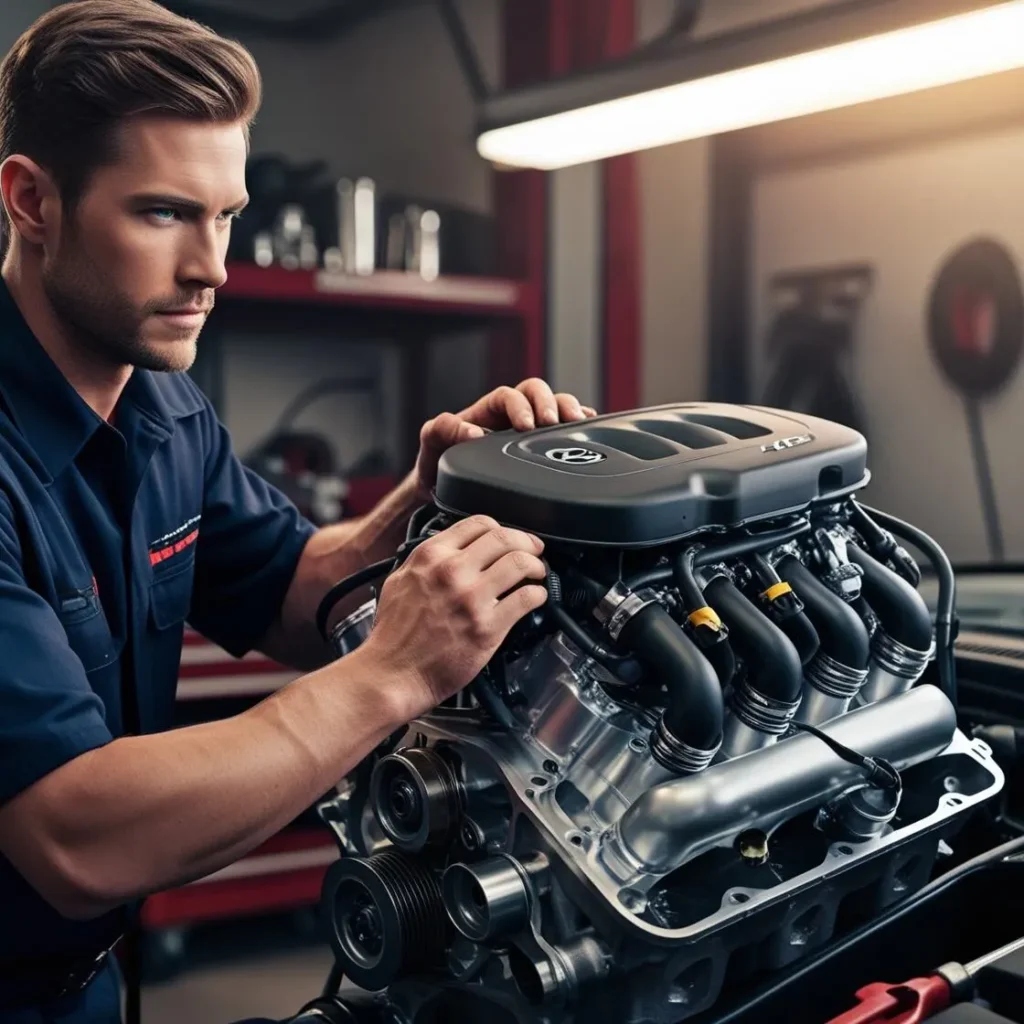The V8 Engine: A Deep Dive into Power and Performance
The V8 engine has become an iconic symbol of American automotive culture, representing power, performance, and a thrilling driving experience. With its distinctive eight-cylinder design, the V8 engine has earned a reputation for delivering impressive horsepower and torque, making it a favorite among enthusiasts and manufacturers alike. In this article, we will explore the history, mechanics, benefits, and applications of the V8 engine, along with its evolution and future prospects. Whether you are a car enthusiast or just curious about automotive technology, this comprehensive guide will provide valuable insights into the world of V8 engines.

Index
The Origins of the V8 Engine
The concept of the V8 engine can be traced back to the early 20th century. While the exact origins are debated, it is widely acknowledged that the first successful V8 engine was developed by the French automaker Lorraine-Dietrich in 1902. However, it was the introduction of the V8 engine by Cadillac in 1915 that truly popularized the design in the automotive industry.
Cadillac’s V8 engine featured a 5.0-liter displacement and was designed to provide greater power and smoother operation than the four-cylinder engines that were commonly used at the time. This innovation quickly gained traction, leading to the widespread adoption of the V8 configuration by many manufacturers, particularly in the United States.
In the following decades, the V8 engine continued to evolve, with advances in technology and design. The introduction of overhead valves in the 1950s allowed for increased efficiency and power output, while the development of smaller, more compact V8 engines in the 1970s and 1980s catered to changing consumer preferences and fuel economy standards.
How the V8 Works
Understanding the mechanics of the V8 requires a basic grasp of how internal combustion engines function. The V8 consists of eight cylinders arranged in two banks of four, forming a “V” shape. Each cylinder houses a piston that moves up and down, creating a reciprocating motion that drives the vehicle.
Here’s a simplified overview of the key components and their functions:
- Cylinders and Pistons: The V8 has eight cylinders, each equipped with a piston. As the pistons move downwards during the intake stroke, they create a vacuum that draws in a mixture of air and fuel.
- Combustion Process: Once the air-fuel mixture is drawn into the cylinders, the pistons move upward to compress the mixture. A spark plug ignites the compressed mixture, causing an explosion that pushes the piston back down, generating power.
- Crankshaft: The pistons are connected to a crankshaft, which converts the linear motion of the pistons into rotational motion. This rotational motion is what ultimately drives the wheels of the vehicle.
- Valves: Each cylinder has intake and exhaust valves that open and close at specific times during the combustion cycle. These valves are controlled by a camshaft, which ensures that the right amount of air-fuel mixture enters the cylinder and that exhaust gases exit after combustion.
- Cooling System: To prevent overheating, the V8 has a cooling system that circulates coolant through passages in the engine block and cylinder heads. This system helps maintain optimal operating temperatures and enhances the engine’s longevity.
The combination of these components allows the V8 to deliver impressive power and torque, making it suitable for a wide range of applications, from high-performance sports cars to heavy-duty trucks.
Advantages of the V8 Engine
The V8 offers several advantages that contribute to its popularity among automotive enthusiasts and manufacturers. Here are some key benefits of V8:
- Power and Performance: One of the most significant advantages of the V8 is its ability to produce high horsepower and torque. This power output translates to faster acceleration and improved towing capabilities, making it ideal for performance vehicles and trucks.
- Smooth Operation: The V8 engine’s design allows for a more balanced and smooth operation compared to smaller engine configurations. The opposing cylinder banks help counterbalance vibrations, resulting in a more refined driving experience.
- Versatility: V8 are versatile and can be found in a variety of vehicles, from luxury sedans and SUVs to sports cars and trucks. This adaptability has solidified the V8’s place in the automotive market.
Common Applications of the V8 Engine
The V8 is commonly used in various vehicle types, each leveraging its strengths for different purposes. Here are some common applications:
- Performance Cars: Many high-performance cars feature V8 due to their ability to produce significant power and provide thrilling acceleration. Models such as the Ford Mustang, Chevrolet Camaro, and Dodge Challenger are iconic examples.
- Trucks and SUVs: V8s are prevalent in pickup trucks and SUVs, where torque is crucial for towing and hauling heavy loads. Vehicles like the Ford F-150 and Chevrolet Silverado utilize V8 to offer robust performance.
- Luxury Cars: In the luxury car segment, V8s are often chosen for their smooth operation and refined power delivery. Brands like Mercedes-Benz, BMW, and Audi frequently offer V8 options in their higher-end models.
- Motorsports: V8 engines have a storied history in motorsports, particularly in NASCAR, where they have dominated the scene for decades. Their power and performance capabilities make them well-suited for competitive racing.
The Evolution of the V8 Engines
The V8 has undergone significant evolution since its inception, adapting to changing technology, consumer preferences, and environmental regulations. Here are some notable developments:
- Turbocharging: To improve fuel efficiency without sacrificing power, many modern V8 engines incorporate turbocharging technology. This allows for smaller displacement engines to produce similar power levels to larger V8s while achieving better fuel economy.
- Hybrid Technology: With the rise of hybrid and electric vehicles, some manufacturers have begun to combine V8 with electric motors to create hybrid systems. This approach offers the benefits of both power and efficiency.
- Direct Fuel Injection: Many contemporary V8 engines feature direct fuel injection, which delivers fuel directly into the combustion chamber. This technology enhances fuel efficiency and power output while reducing emissions.
Future of the V8
As the automotive industry continues to evolve, the future of the V8 engine remains a topic of discussion. While there are growing trends toward electrification and downsizing engines, the V8 engine’s legacy is far from over. Enthusiasts appreciate the unique driving experience and power characteristics that a V8 engine offers, and many manufacturers are committed to maintaining this tradition.
In response to environmental concerns, manufacturers are also developing cleaner V8 options with improved emissions performance. For example, advancements in emissions technology and stricter regulations are prompting automakers to innovate while still delivering the power and performance that drivers desire.
Land Rover V8: A Legacy of Power and Durability
The Land Rover V8 engine is renowned for blending power with off-road capability, making it a staple in Land Rover’s lineup for decades. Introduced as an option to deliver enhanced performance, the Land Rover V8 offers robust power output, making it ideal for rugged terrains and heavy-duty usage. This engine configuration not only enhances towing capacity but also ensures a smooth and consistent drive, even under challenging conditions.
Land Rover’s commitment to the V8 has evolved over time, with modern versions incorporating advanced technology like turbocharging and direct fuel injection for better fuel efficiency and reduced emissions. These innovations allow the Land Rover V8 to meet stringent environmental standards without compromising on the strength and reliability Land Rover owners expect. From the Range Rover to the Defender, the V8 remains a cornerstone of the Land Rover lineup, providing drivers with the confidence and capability to tackle any terrain.
This commitment to the Land Rover V8 highlights the brand’s dedication to delivering high-performance engines that embody both luxury and rugged capability, ensuring that it remains a preferred choice for adventure and off-road enthusiasts worldwide.
Conclusion
The V8 engine has left an indelible mark on the automotive landscape, symbolizing power, performance, and innovation. With its rich history and ongoing evolution, the V8 engine remains a favorite among car enthusiasts and drivers seeking a thrilling driving experience. Whether in sports cars, trucks, or luxury vehicles, the V8 continues to prove its worth and adaptability.
As we look to the future, the V8 engine may face challenges from emerging technologies and shifting consumer preferences. However, its legacy of power and performance ensures that it will continue to be a significant player in the automotive world for years to come.
